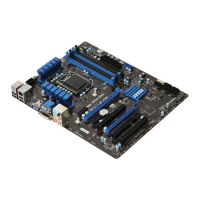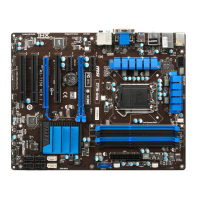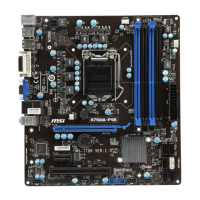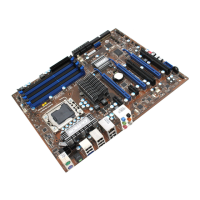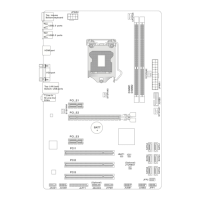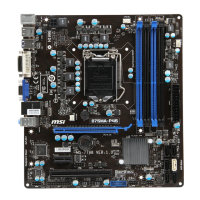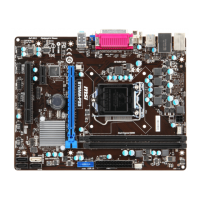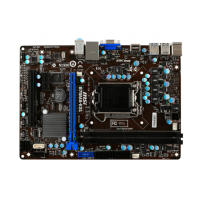Do you have a question about the MSI B75A-G43 seres and is the answer not in the manual?
Standard legal disclaimer regarding the intellectual property of the document's content and potential for changes.
Lists registered trademarks of various companies mentioned in the manual.
Details the revision history of the manual, including the first release date.
Provides information on how to obtain technical assistance and resources from MSI.
Essential guidelines for safe operation, handling, and installation of the equipment.
Statement regarding compliance with FCC rules for Class B digital devices and potential interference.
Information on proper disposal and recycling of batteries according to regional regulations.
Information on chemical substances in products, in compliance with EU REACH Regulation.
Statement regarding the Waste Electrical and Electronic Equipment directive for environmental protection.
Lists the items included in the mainboard package, such as the mainboard, DVD, and accessories.
Details optional accessories that may be purchased separately for enhanced functionality.
Important instructions and warnings to prevent damage during component installation, especially ESD.
Provides detailed technical specifications of the mainboard, including CPU, memory, and connectivity.
A visual diagram illustrating the location and labels of various connectors on the mainboard.
Illustrates and explains the function of the ports located on the mainboard's back panel.
Guide on installing the CPU, including alignment keys, thermal paste, and cooler mounting.
Instructions on how to properly mount the mainboard into the computer case using standoffs and screws.
Details on connecting the ATX 24-pin and 8-pin power connectors to the mainboard.
Instructions for installing DDR3 memory modules and understanding Dual-Channel mode population rules.
Information on PCIe and PCI expansion slots for installing graphics cards and other add-on devices.
Guidance on installing single video cards and leveraging the CPU's integrated graphics.
Instructions for setting up AMD CrossFire multi-GPU technology for enhanced gaming performance.
Detailed descriptions and diagrams for various internal connectors on the mainboard.
Explains the connection and function of CPU and system fan power connectors for cooling.
Guide for connecting the computer case's front panel switches and LEDs to the mainboard.
Details on connecting the USB 3.0 expansion connector for high-speed data transfer.
Explains the connection of USB 2.0 expansion connectors for peripherals.
Information on the chassis intrusion connector for security monitoring.
Guide for connecting the computer case's front panel audio jacks to the mainboard.
Details on connecting a Trusted Platform Module (TPM) for enhanced security.
Description of the 16550A serial port connector for attaching serial devices.
Information on connecting an optional parallel port bracket for printer connectivity.
Details on the optional Voice Genie connector for voice control modules.
Explanation of the Clear CMOS Jumper (JBAT1) for resetting system configuration data.
Instructions on how to access the BIOS setup menu using the DEL or F11 keys during boot.
An overview of the CLICK BIOS II interface, highlighting key areas like system information and menu selection.
Explains how to view and change the boot device priority using icons and drag-and-drop functionality.
Describes how to navigate and interact with the BIOS settings using keyboard hotkeys and mouse controls.
Displays system information such as date, time, CPU details, memory, and SATA device connections.
Covers advanced configurations for PCI, ACPI, integrated peripherals, graphics, USB, and serial/parallel ports.
Details features for monitoring system temperatures, voltages, and fan speeds for optimal performance.
Configuration options for power saving modes, including EuP 2013, C1E, and C-States.
Settings to configure system wake-up events from various power saving states via PCI, USB, or PS/2 devices.
Options for controlling the boot process, including full screen logo display and boot device prioritization.
Options for saving changes, discarding changes, rebooting, and loading default BIOS settings.
Advanced settings for CPU and DRAM frequency, ratios, voltages, and timings to enhance performance.
Settings related to energy saving, including EuP 2013, C1E support, and Intel C-State management.
Information on accessing the integrated MSI Winki web browser for internet and email functions.
Details on built-in utilities for HDD backup, Live Update for BIOS/drivers, and M-Flash for BIOS updates.
Features for securing the system, including administrator/user passwords and chassis intrusion detection.
Step-by-step guide for installing the Realtek HD Audio driver for proper audio operations.
Overview of the Realtek HD Audio Manager panel for configuring speaker setup and sound effects.
Explains the dialogue window that prompts users to select device type when plugging into audio jacks.
Diagrams illustrating the default audio back panel jack connections for 2-channel, 4-channel, 6-channel, and 8-channel speakers.
| Chipset | Intel B75 |
|---|---|
| Socket | LGA 1155 |
| Form Factor | ATX |
| Max Memory | 32GB |
| Memory Standard | DDR3 1066/1333/1600 |
| PCI Express x1 | 2 |
| PCI Slots | 3 |
| SATA 3Gb/s | 5 |
| SATA 6Gb/s | 1 |
| Audio | Realtek ALC892 |
| USB 3.0 | 2 x Rear, 2 x Header |
| LAN | Realtek 8111E |
| Video Outputs | VGA, DVI, HDMI |
| Memory Slots | 4 x DIMM |
